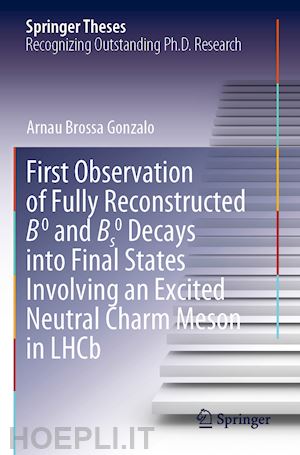
Questo prodotto usufruisce delle SPEDIZIONI GRATIS
selezionando l'opzione Corriere Veloce in fase di ordine.
Pagabile anche con Carta della cultura giovani e del merito, 18App Bonus Cultura e Carta del Docente
This book presents the latest results on the branching fraction and phase space distribution of B0 and Bs0 decays into final states including excited neutral charm mesons. This work represents four years of research, and the book describes in detail all the necessary steps and techniques required to perform a physics analysis of the data recorded by the LHCb experiment in the years 2016–2018.
Although the results presented in this book represent the first measurement of such decays, the text is written in a manner accessible to Ph.D. students and early career researchers. Thus, all the contents included in this book are described in a pedagogical way, including technical details that would allow the results to be reproduced in future. In addition to the methodology used to perform these measurements, the book also includes a description of the theoretical background required to interpret the results presented, as well as a technical description of the LHCb detector, which provided the data sample used in this study.
Arnau Brossa Gonzalo is a postdoctoral researcher at the Instituto Galego de Fisica de Altas Enerxias (IGFAE). He specialises in big data analysis in the context of high-energy physics after six years as an active researcher for the LHCb collaboration.
His first contact with the field was in 2016 while undertaking the M.Sc. in Astrophysics, Particle Physics and Cosmology at the University of Barcelona (Spain). There, he had the opportunity to join the ICCUB, a research centre associated to the LHCb collaboration where he prepared his master thesis, focusing on the study of rare b baryon decays with long-lived tracks within the LHCb detector. In 2017, thanks to the international nature of working within the LHCb collaboration, he continued his career as a Ph.D. researcher at the University of Warwick (England), where he further developed his data analysis skills by performing a study of B hadron decays into excited charm mesons, which culminated in the results described in his Ph.D. thesis. He also participated in outreach and teaching projects organised by the LHCb collaboration, both to people inside the field and to the general public.After achieving his Ph.D. degree in Physics at the University of Warwick in 2021, he started his current position at IGFAE as a postdoctoral researcher, where he is studying charm and semileptonic decays in the LHCb experiment as well as mentoring Ph.D. students.











Il sito utilizza cookie ed altri strumenti di tracciamento che raccolgono informazioni dal dispositivo dell’utente. Oltre ai cookie tecnici ed analitici aggregati, strettamente necessari per il funzionamento di questo sito web, previo consenso dell’utente possono essere installati cookie di profilazione e marketing e cookie dei social media. Cliccando su “Accetto tutti i cookie” saranno attivate tutte le categorie di cookie. Per accettare solo deterninate categorie di cookie, cliccare invece su “Impostazioni cookie”. Chiudendo il banner o continuando a navigare saranno installati solo cookie tecnici. Per maggiori dettagli, consultare la Cookie Policy.